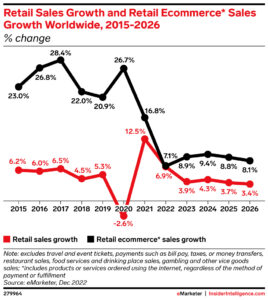In the highly competitive world of ecommerce, meeting customer expectations and providing a strong positive customer experience is crucial. A PwC study found that 17% of customers abandon a brand after just one negative experience. To stay ahead, retailers must embrace the latest UX, technology and AI trends to provide a personalized and seamless shopping experience.
In the Ecommerce Growth Show session “Is A Good Ecommerce Experience Good Enough?”, you’ll learn from Abercrombie, Snipes, GoPro and Narvar about how they are innovating in ecommerce today. We interviewed the moderator Zia Daniell Wigder, Chief Content Officer at Insider Intelligence, to give you a sneak peek of what’s to come in the session on June 21st. Make sure you’re registered to attend and read on for the full interview.
To help contextualize the importance of this panel, Wigder shared the following graph, highlighting the growth of overall retail versus retail ecommerce sales on a worldwide basis. Through 2019, growth rates of ecommerce sales were roughly 15-20 percentage points above those of overall retail sales; now, there is about a five percentage point difference projected over the next three years.

Wigder: As you see in the chart, overall retail and ecommerce sales are growing at rates that are much closer than we saw in the past. There are a number of implications, but one takeaway is that digital leaders will have their work cut out for them as they continue to compete for budgets with other divisions of the business; they no longer have the same stratospheric growth rates on their side.
Teichmann: In your opinion, what makes a good ecommerce experience?
Wigder: It distills down to one simple thing: a good ecommerce experience results in a purchase. It doesn’t mean that the shopper is going to buy at that moment; it could be a good experience that causes them to make a purchase at a later date, or in a store, or it could be that the person becomes an advocate or influences a family member or friend to make a purchase. But it ultimately all comes to driving a transaction.
Teichmann: How can retailers build a culture of continuous improvement to ensure that they’re always providing the best possible ecommerce experience?
Wigder: Almost every brand or retailer could do more to communicate with the end user; oftentimes that piece is missing. I made a purchase from a digitally native shoe brand recently, waited about a week and after seeing there was no update on the order, I contacted them. They then told me the product was backordered and wouldn’t arrive for 3-4 weeks. For something like that, all you need to do is communicate upfront that it’s going to be a little longer […] or say “hey we’re running late—do you want to cancel?” or “do you want to make a purchase of a different style?”. It was that lack of communication that created a negative customer experience for something that didn’t need to be negative… we’re all human and businesses are hard to run, so I think that communication piece is one thing that goes a long way with shoppers.
Teichmann: Why is there a gap in retailers’ communication to the end users?
Wigder: It’s a few things. One is having the data to be able to say, even before purchase, “that particular shoe style is going to be delayed;” it is also putting in place the mechanism in place to communicate. So it’s not only having sufficient inventory visibility, but also having the right data to identify which customers ordered newly backordered or out-of-stock products, and ensuring the messaging is in place to communicate potential delays. Brands should be proactively managing all of these different parts.
Teichmann: The panel will explore the latest UX, technology, and AI trends in ecommerce. Which of these trends do you believe is having the biggest impact on the customer experience, and why?
Wigder: We’ve been talking about AI for a long time, and a lot of the customer experience is already being AI powered. These days people sometimes use “AI” as a substitute for generative AI, but they’re not the same thing. We’re at the very early stages of generative AI and large language models. In the short term, you’ll see this emerging technology disrupting areas like content marketing, including optimizing website content or writing product descriptions. The shopper may not initially see a massive difference as a result of these initial use cases, but from an operational perspective, we’ll see a big shift. You’ll find writers becoming much more efficient in their ability to create content, and businesses will be able to create more effective content by using customer feedback. For all of us, learning how to harness generative AI will be key. Writing prompts effectively is definitely art and not science; we’re learning how and where you can apply this new technology. All of us are in learning mode.
For more on AI, take a look at the session on Generative AI with Kate Spade.
Teichmann: What are the latest emerging trends in ecommerce and customer experience that retailers are not paying attention to yet?
Wigder: Right now we’re in this throwback period where a lot of issues that were talked about in the past are now back in the spotlight. Take something like returns; retailers have struggled with this area for a long time, but the issue is front and center again. Retailers are admitting some parts of the business like this one are still really hard to do profitability; they’re starting to question if they should buck conventional wisdom and start charging for returns. Suddenly we’re talking about changes to the business that would’ve been unthinkable in the past. When we’re in this time of constrained margins, everything is fair game in a way it might not have been before.
Teichmann: You teach courses about digital transformation for global ecommerce executives. Can you share what you’ve heard from them about innovating in ecommerce and improving the customer experience?
Wigder: Creating a great ecommerce customer experience gets more complex every day because the number of touchpoints constantly increases. Early retail centered around wholesale models and stores, but we added digital along with a growing range of digital channels including direct, voice, social, livestreaming…it’s not easy to ensure you’ve got the right message and experience across all of them. Having a good customer experience is no longer “how do we take this one thing and replicate it everywhere,” but rather creating a variety of new types of experiences. Your TikTok experience is supposed to be consistent with your brand but that’s going to be a totally different look and feel than what you have on your website. This idea that CX is kind of a single thing or a single consistent brand experience is no longer the case. It’s become a much more complex undertaking than it has at any point in the past.
Teichmann: What do you hope attendees will gain from this panel at the Ecommerce Growth Show?
Wigder: Our goal is to give hard data or really concrete examples that go beyond the idea of putting the customer at the center of the experience. What specifically does that mean at your business? What have you learned? What’s different now in terms of how the customer shops compared to just two years ago? My goal will be to get the panelists to be as detailed as they can be on stage.
Register today for the Ecommerce Growth Show to attend this amazing panel with:
- Samir Desai, EVP, Chief Digital + Technology Officer, Abercrombie & Fitch
- Jenna Flateman Posner, CDO, Snipes
- Kacey Sharrett, VP Direct to Consumer, GoPro
- Anisa Kumar, CCO, Narvar
- Zia Daniell Wigder, Chief Content Officer, Insider Intelligence (Moderator)
You don’t want to miss out!
Related Posts
-
Uncover the Secrets of Customer Marketing at The 2023 CommerceNext Ecommerce Conference
Get excited for the upcoming Ecommerce Growth Show, taking place…
-
Learn All About Consumer Retention & Loyalty at The 2023 Ecommerce Conference
Get ready for the annual 2023 CommerceNext Ecommerce Growth Show…
-
EXCLUSIVE: The 4 Hottest Topics at the 2023 Ecommerce Growth Show
The 2023 CommerceNext Ecommerce Growth Show is set to be…




